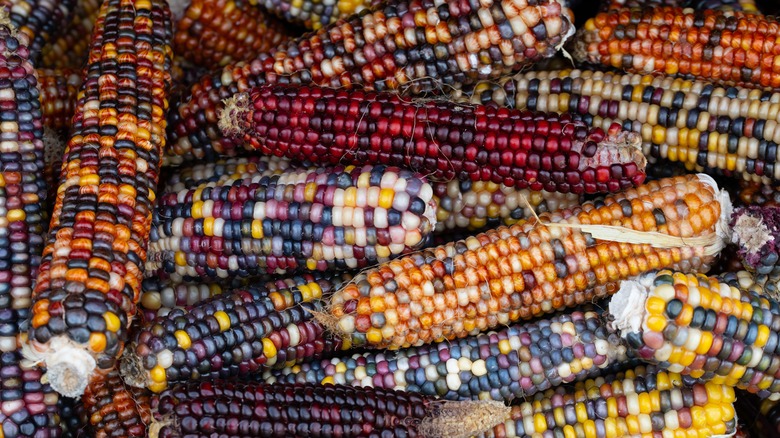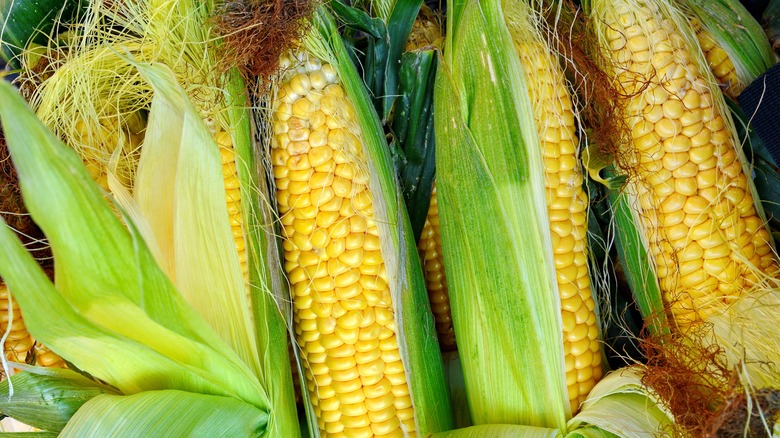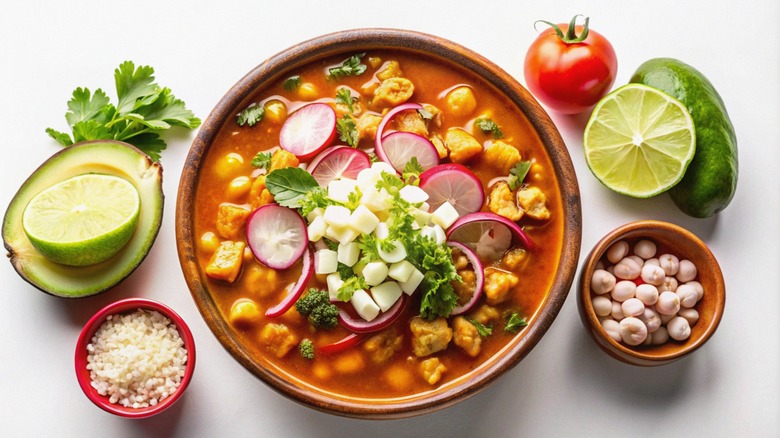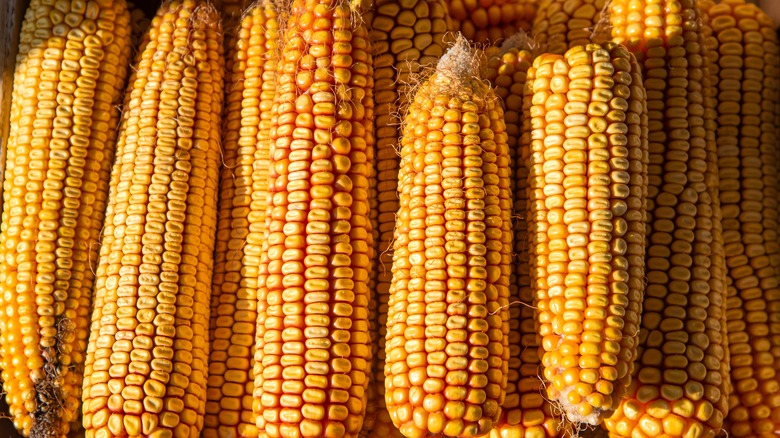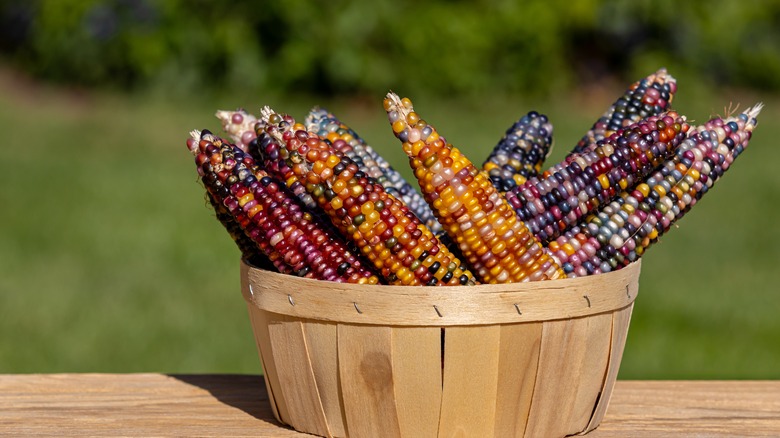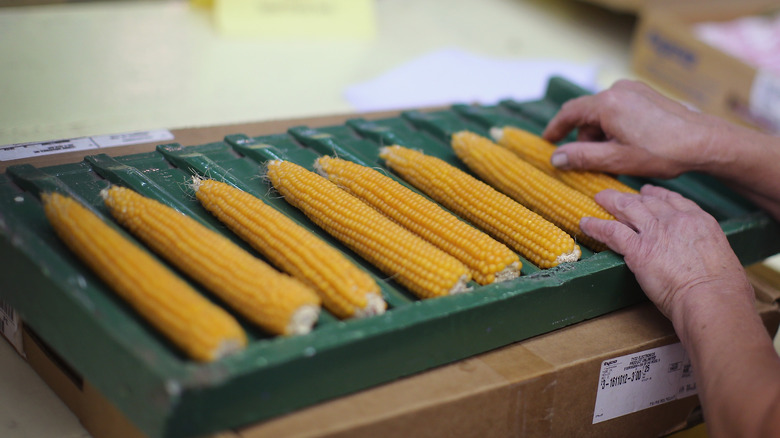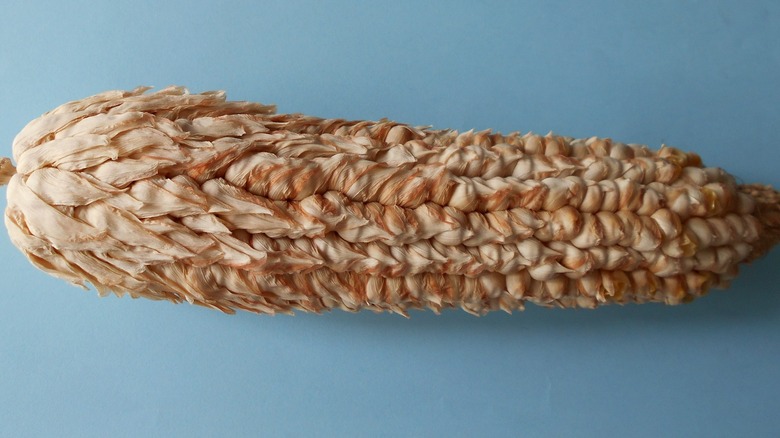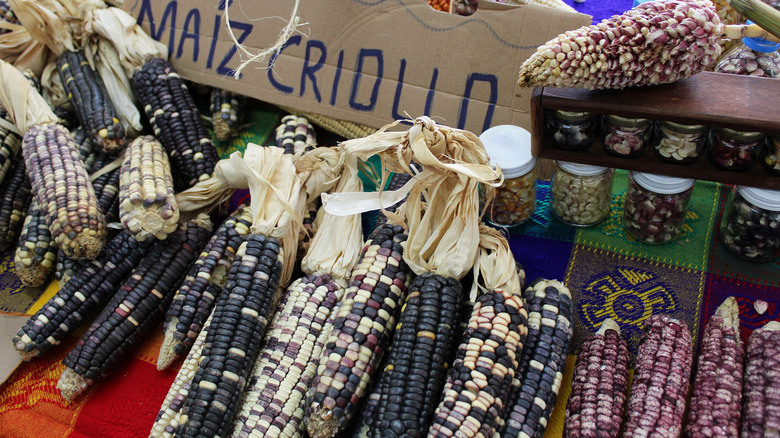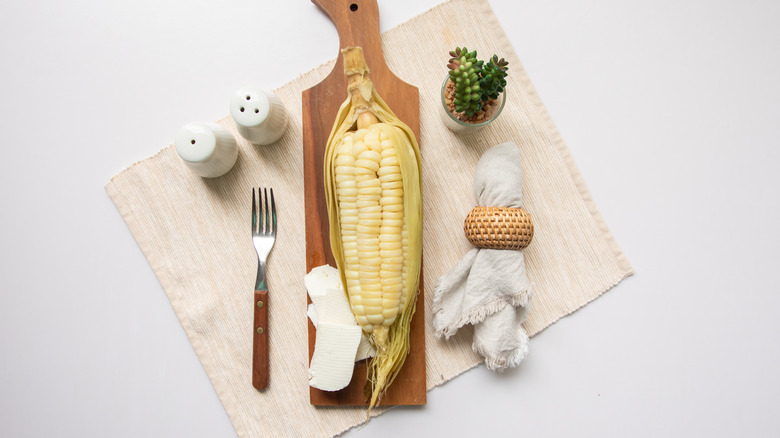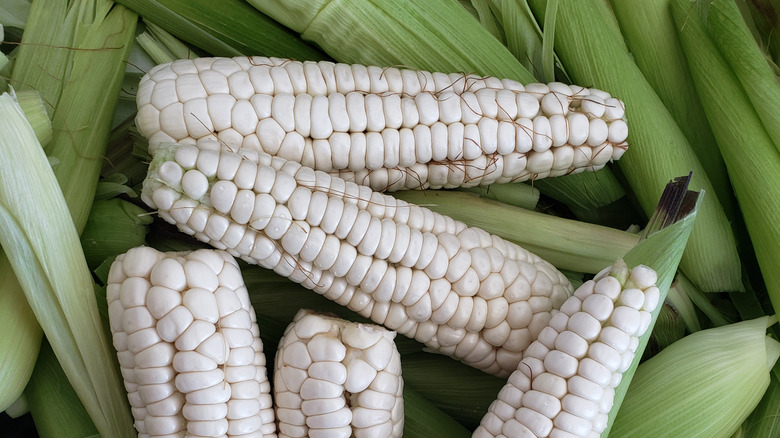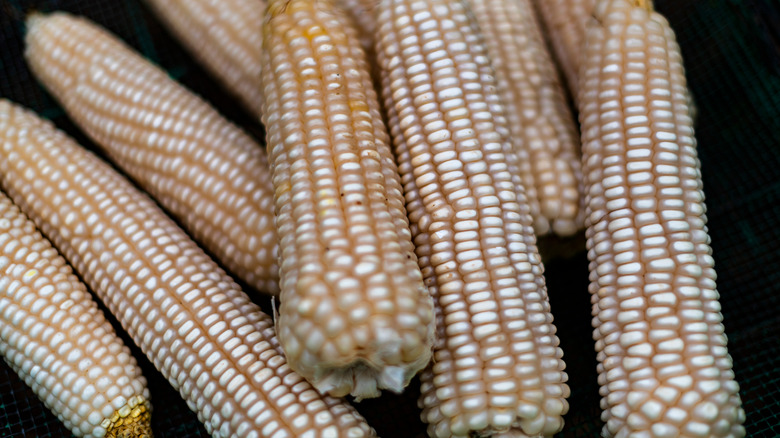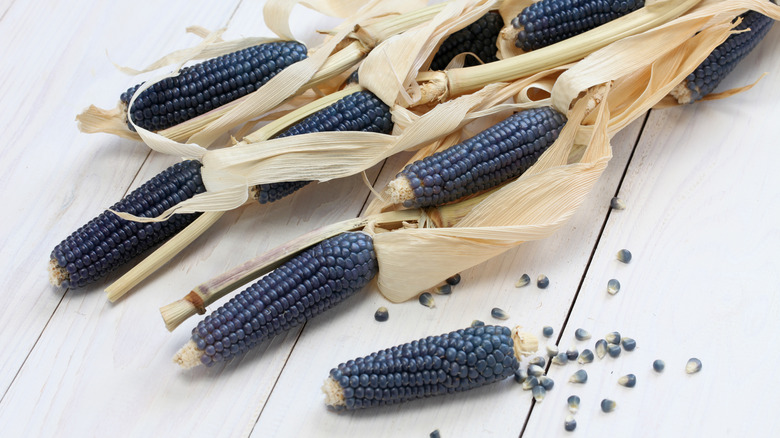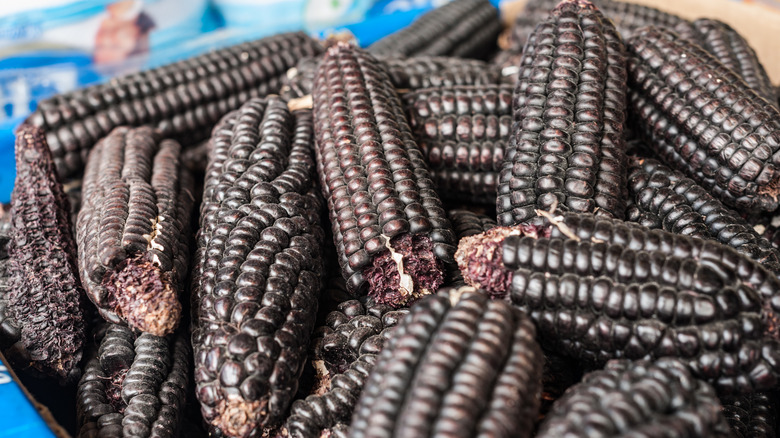12 Types Of Corn And The Absolute Best Ways To Use Them
There are far more types of corn in the world than you probably supposed, so we wanted to bring you a list of 12 popular ones and how to use them. If you've only ever tried sweet corn and popcorn, you're going to be pleasantly surprised to learn about the many other varieties of corn out there.
The corn we eat today looks nothing like how corn began. It had its origin in ancient Mesoamerica, where it originated as a type of wild grass that humans cultivated over 8,700 years ago for the grains to be ever more edible. Teosinte is a type of wild corn that is believed to be the original plant the ancients cultivated into the corn we have today. Its name comes from a Náhuatl word (teocintli) meaning "grass of the gods." Modern corn comes from hybrid corn humans bred around 5,000 years ago in Mexico. Scientifically, the corn we eat today is all known as Zea mays. While you can find several varieties in the U.S., most aren't regularly part of the cuisine as they are in Mesoamerica.
While you might find some of the following varieties of corn in the U.S., others are more likely to be found in Mesoamerican countries like Mexico or Peru.
1. Sweet corn
Most of the corn that we eat in the U.S. is sweet corn (Zea mays dulce), and it comes in many varieties. The tribes of the Haudenosaunee Confederacy (also known as the Iroquois) were growing sweet corn in what later became the northern U.S. and Canada. They introduced it to European settlers in 1779. By the 1800s, colonists started eating sweet corn more widely. Heirloom varieties like Country Gentleman and Stowell's Green that were grown then still exist today, but you probably won't find them anywhere except for a seed catalog or farmer's market. However, a few other interesting varieties like shoepeg sweet corn sometimes show up in grocery stores.
Sweet corn is technically a mutant. It developed as a result of a genetic mutation in harder varieties of corn like flint and flour corn. The mutation increased sugar and decreased starch in kernels, making it extra sweet and juicy when it's young and in what's known as its milk stage. Some versions are sweeter than others.
There are many recipes for sweet corn. You've likely eaten it as corn on the cob, whole kernel corn, and creamed corn. You can also dry it, grind it, and turn it into a sweet version of cornmeal. Using ancient Puebloan methods, people in New Mexico steam sweet corn over a wood fire overnight and sun-dry it for a week. The dried version is called chicos and is rehydrated to make other dishes like stew, pico de gallo, and more.
2. Flour corn (soft corn)
Flour corn or soft corn (Zea mays amylacea) was one of the main types grown by many American Indian tribes and has various uses. It's sweeter than flint corn, but without the same mutation as sweet corn. This means it's not going to be as sweet as you're likely used to. Because it doesn't have as much oil and protein as other varieties like flint, the flavor is nice and delicate. If you are looking for more flavor, blue or red flour corn varieties are your best bets.
True to its name, flour corn is among the easiest types to dry and grind into corn flour. That's because the starch in it is softer and the outer coat is thin. Like sweet corn, it's best consumed when it's in its young milk stage. However, it is a bit chewy.
There are more uses than one for flour corn. When it's dried, you can turn it into fine cornmeal. It's even possible to make it at home with a heavy-duty blender or food processor. For added richness, consider roasting it before drying. Then, it can be turned into tortillas or tamales. Flour corn cornmeal can also be made into a sweetened Mexican drink called pinole. You can use flour corn whole, too. It's especially good to boil, steam, roast, or add to the classic Mexican soup known as pozole. Parched kernels also make excellent corn nuts.
3. Dent corn (field corn)
Dent corn (Zea mays indentata) is the most widely-grown corn variety in the U.S. and the world. It's also known as field corn. While it often gets turned into animal feed, it has plenty of culinary uses for humans as well. Once you notice the small dent in each corn kernel as it dries, you'll realize where this variety gets its name.
Dent corn is grainy with lots of soft starch. While it's not as sweet as sweet corn, it still has a bit of sweetness when it's in its young milk stage.
Many of the foods that are made with dent corn go through a process known nixtamalization to improve its flavor and nutritional value. Once corn has been nixtamalized with an alkaline solution that typically includes lime, it's often turned into hominy, grits, or flourlike masa. Its high starch content makes it ideal for cornmeal, too. Dent corn cornmeal turns into everything from cornbread and tortillas, to tortilla chips and taco shells. Since it can be eaten whole but isn't that sweet, it often needs a little help from other ingredients. In Mexico, It's sometimes turned into elote with lots of toppings to maximize flavor or can be used in a flavorful pozole soup.
4. Flint corn (Indian corn)
Flint corn (Zea mays indurata) is known by several other names, including Indian corn and calico corn (in reference to its multi-colored kernels). It's one of the three types of corn that American Indian tribes grew as a food source. The fact that flint corn gets its common name from its tough outer layer gives you a good idea of the texture of this corn. That hardness gives the kernels a glass-like appearance that makes many people assume a cob is just decorative. However, flint corn is edible and has a rather robust flavor that comes from its many oils and proteins.
Flint corn is another starchy rather than sweet corn variety. While it can have a bit of sweetness when it's young and in its milk stage, it's nowhere near as sugary as sweet corn. The starch also gives it a rather gummy texture.
Flint corn is another type of corn that benefits from being nixtamalized. After nixtamalization, it's often turned into masa to make items like tortillas or turned into hominy to make dishes like grits or pozole. Italian cooks often use coarsely-ground flint corn to make polenta. In Mexico, flint cornmeal is sometimes turned into a drink known as atole. While it's possible to pop flint corn, it merely cracks open rather than fluffing out like popcorn does. A better snack option for this variety would be corn nuts.
5. Popcorn
While we probably don't need to explain popcorn itself to you, you might not know a lot about what makes the popcorn corn variety (Zea mays everta) best for popping. Popcorn has been around for a while, with the oldest specimens ever found being 5,600 years old and coming from a New Mexican cave.
A lot of what we've described about flint corn is true for popcorn. Like flint corn, the kernels are hard and shiny like glass beads. Yet, the outside of these semi-translucent kernel shells are brittle enough to pop. When steam builds to the right pressure levels inside heated popcorn kernels, it explodes into a fluffy white snack. No matter the outside color of the shell, it will pop up white.
While dried popcorn is great for ... well ... popcorn, it's not really a type of corn you want to try to eat fresh or whole. However, like other types of hard corn, you can nixtamalize popcorn and turn it into corn masa or hominy. This means it's possible to use it to make foods like tamales, tortillas, or atole from it. It's also able to be ground down to make coarse grits or polenta. Curiously, you can use unpopped popcorn kernels and a blender or food processor to make your own coarsely-ground cornmeal.
6. Pod corn
Pod corn (Zea mays tunicata) is perhaps the most unique-looking corn on our list since each individual kernel of corn contains its own individual husk (also called a glume). It's reminiscent of seed pods found in various types of grasses. Archaeologists have studied specimens from the San Marcos Cave in Mexico that date back to between 5,200 and 3,400 B.C. Today, you can find it in Mesoamerica and South America or from seed catalogs.
Like sweet corn, pod corn arose from a mutation rather than intentional human cultivation. The mutation in pod corn happened in the gene responsible for leaves and essentially creates small leaves around each kernel rather than the whole cob.
Pod corn is practically always decorative. While we couldn't find any recipes that call for it, there's some indication you could attempt to eat this variety if you really wanted to try. That said, it would be especially time consuming to prepare because you would have to husk each kernel, which means it's probably not worth the effort.
[Featured image by Sang83 via Wikimedia Commons | Cropped and scaled | CC BY-SA 4.0]
7. Heirloom corn (criollo maize or landraces)
Heirloom corn actually represents a wide variety of corn types. When it comes to corn in the U.S., the vast majority of it comes from hybrid varieties that farmers have bred to suit agricultural or flavor purposes. Meanwhile, heirloom corn has changed more through natural selection rather than hybridization with other varieties. Farmers have continued growing such types from season to season and have passed them to subsequent generations.
While some heirloom corn varieties have been in existence for just hundreds of years, others have a history that goes back for millennia. As such, many heirloom varieties are ones that American Indians grew. Other terms you might hear for heirloom corn is "criollo maize" or "landraces," which is corn that continues to be cultivated by indigenous cultures in Mesoamerica. Different regions and communities have their own unique varieties, which often play a part in local cuisine. In Mexico alone, there are at least 60 heirloom types of corn.
You can find heirloom varieties of the types of corn we've previously mentioned, such as sweet, flint, dent, and flour corn, meaning they don't represent any one subspecies of corn. If you have the chance to try heirloom corn, you might be surprised by just how flavorful and rich some varieties are. However, it's good to know what subspecies of heriloom corn you have is so that you know whether it's best cooked fresh, ground into cornmeal, or nixtamalized.
[Featured image by Feria de Productores via Wikimedia Commons | Cropped and scaled | CC BY 2.0]
8. Choclo
A famous variety of corn from Peru is a large-kerneled corn called choclo. It's thought to have originated with the Incan culture. However, you can find it throughout the world today through exports. Not only are the kernels of cholo enormous, but they're also chewy. The taste is different, too, tending toward being somewhat nutty.
If you've ever wondered what type of corn the large corn nuts you buy at the store are, it's usually choclo. To turn them into corn nuts, dried choclo is rehydrated for a few days in vats of water. While some are toasted, others are deep fried to get the nice crunch you enjoy. There are some other ways to enjoy choclo as well. One popular choclo dish in Peru is choclo con queso, which is choclo served on the cob with a side of cheese and sometimes with chili pepper sauce as well. There's a North Peruvian stew called pepian de choclo that combines the corn with chilis, garlic, and onions. You can also find a Peruvian cheese, veggie, olive, and choclo salad called solterito. Some other uses include mixing it into rice dishes, or grinding it to use in dishes like empanadas and tamales. In Colombia, choclo cornmeal is sometimes used to make arepas.
9. Cacahuazintle (maiz pozolero)
Cacahuazintle is a common Mexican variety of corn that you will find in Mexico City and other areas nearby. The name comes from two Náhuatl words that mean corn and cacao (cacáhuatl and centli). That makes sense when you realize that the kernels look a lot like raw cacao pods. This type of corn is easy to identify because it has larger, harder, and thicker kernels than many other varieties of corn. Plus, it has a mealy, floury starch that further sets it apart.
Because it's a hard variety of corn, many use nixtamalization to soften it and make it much easier to digest. One of the most common dishes you'll see using cacahuazintle is pozole. In fact, some purists in Central Mexico feel that it shouldn't be used for anything else. However, many others argue that there are plenty of other uses for this corn. In Mexico, you might eat it on the cob, in menudo soup, as the main ingredient in a type of boiled and toasted corn called esquites, in tamales, in drinks, and more.
10. Chapalote (conical maize)
Chapalote (conical maize) is a type of Mexican corn that you can recognize by its long, cone-like shape that tapers at the end. It ranges in color from dark brown and coffee-colored kernels to caramel-colored kernels. The Aztecs and other ancient groups in Mesoamerica and the Southwest part of the U.S. enjoyed chapalote, bringing it forward into the future through their ancestors. Some of the earliest ever found that is similar to today's chapalote dates from 4,100 to 4,200 years ago, and archeologists have uncovered vast prehistoric irrigation systems used to keep it growing. The flavor is unique in that it's not only slightly sweet, but it also has rich earthy and nutty undertones.
It's common to grind chapalote into cornmeal and use the cornmeal to make traditional Mexican dishes like corn tortillas and tamales. Roasted chapalote corn meal is also used to make the spiced warm Mexican drink called chapalote pinole. In ancient times, roasted chapalote corn meal was simply added to water to create an early non-caffeinated form of energy drink to keep people going through their day. Modern chefs have also experimented with the idea of using it in salads, soups, and desserts.
11. Blue corn (blue maize)
Blue corn (Zea mays azul) is a Mexican type of corn known for its distinctive dark blue or purple corn kernels. It has several sub-varieties (like Hopi Maize and Rio Grande Blue) and is technically a type of flint corn. However, since it has high levels of anthocyanins, the corn and everything you make with it turns out blue. It also has a markedly robust nutty flavor.
There are several health benefits to eating blue corn. If you're looking for corn with a lower glycemic index, it's better to choose items made with blue corn rather than yellow or white corn. It adds more protein to your diet than yellow corn does. The anthocyanins that turn the corn blue are also strong antioxidants. The Cleveland Clinic says that there are studies that suggest that, in some cases, anthocyanins may lower blood pressure, improve heart health, improve brain function, and slow or stop cancer growth.
Some blue corn food items you can find made with blue cornmeal include blue corn tortillas, tamales, and tlacoyos (stuffed corn tortillas). You may also find bags of blue tortilla chips available to purchase. Blue cornmeal can also feature in a warm mug of atole de pinole.
12. Purple corn (maize morado)
Purple corn is another type of corn that comes to us from in and around what's now Peru. Depictions in ancient South American pottery indicate that it's been around at least 2,500 years. It's thought to come from an even older purple corn variety called kculli, known by the indigenous cultures as "the plant of remembrance."
The possible health benefits for purple corn may make you decide to add it to your diet. Like blue corn, purple corn gets its color from anthocyanin. According to the USDA, the anthocyanin in purple corn can possibly help combat a variety of ailments related to obesity, and inflammation. It may be valuable in fighting heart disease, some types of cancer, and diabetes (though research is still ongoing).
In Peru, purple corn is used in drinks, including the spiced and fruity chicha morada. It features in bread and tortillas. You can also find it in a variety of desserts, such as pudding, popsicles, and sorbets.
